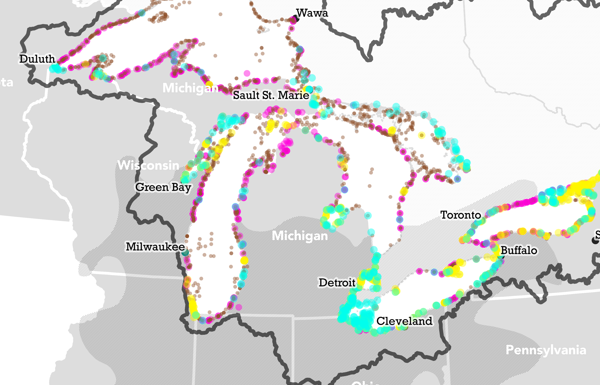
Lake sturgeon, one of the largest and oldest species of fish in the Great Lakes, are in more trouble than we thought.
In December, the International Union for the Conservation of Nature downgraded its status from Least Concern to Endangered based on shrinking populations over the past three generations, which is between 250 and 300 years for this long-lived fish.
“It’s one of the oldest species in the world, it’s been around since the time of the dinosaurs,” said Dan Krause, director of national conservation for the Wildlife Conservation Society of Canada. “They have persisted through lots of changes, but are struggling with humans.”
Lake sturgeon were once incredibly abundant in the Great Lakes, and the largest proportion of the remaining population still lives there. But the Great Lakes population is estimated to be less than 1% of its historical numbers. When European settlers arrived in the area they began constructing dams and other barriers that cut the fish off from their spawning areas, which can be hundreds of miles upriver. Overharvesting – first as a “junk fish” that was either discarded or even burned as fuel, and later for food and caviar – and pollution also played a role in their decline. The healthiest populations now live in far northern Ontario, in the rivers flowing into Hudson and James Bay.
But it is not all bad news for the sturgeon. The change in conservation status does not actually indicate a sudden, recent downturn in population. Rather, it is based on a refined assessment of the data, so the previous 2004 listing of “least concern” was too optimistic. Sturgeon have actually been endangered for longer than we thought.
And, in many places, they are starting to recover. Efforts to restore lost habitat in the Detroit River, for example, have led to sturgeon starting to reappear in that area.
“Their numbers are increasing again after a long history of decline,” Krause said. “They are now returning to places where they have been absent for generations.”
In 2012, the state of Michigan launched a restoration plan with the goal of restoring habitat and reintroducing fish to build self-sustaining populations within 20 years, said Meaghan Gass, Sea Grant Extension Educator at Michigan State University. After several years of habitat improvements in rivers around Saginaw Bay in Lake Huron, where the fish were previously extirpated, sturgeon were reintroduced starting in 2017. So far almost 5,000 fish have been released, and they seem to be doing well. Juvenile fish have been found out in the bay, and ice fishers reported catching juvenile sturgeon in 2019, for the first time in more than 100 years.
Gass says the slow recovery of sturgeon is a sign of the lakes’ improving health overall.
“They are a living sentinel for the Great Lakes,” she said. “They need good habitat and water quality, so it is a good sign when they come back.”
Catch more news at Great Lakes Now:
AI technology could be used to monitor invaders in the Great Lakes
Lake heatwaves driven by human-caused climate change
Featured image: Two sturgeon await their release into the wild after being cared for by students as part of an educational program created by the Little Traverse Bay Band of Odawa Indians. (Photo Credit: GLN)
3 Comments
-
This article can’t even mention the work done by Tribes in the Great Lakes? They have been working on sturgeon restoration well before the State of MI in 2012. It has been well documented too And you even use a picture from a Tribe, you can’t make it up! No excuse for it. Great Lakes Now implicit bias (or worse) is showing. May I suggest some anti-bias/racisms training…
(I am white, not native) -
Thank you very much for your part in preserving a species for future generations what an incentive for the rest of us to respect the Great Lakes
-
Dead sturgeon are washing up on Lake Michigan beaches per posts on
Facebook. One 4 1/2 ‘ Manistee and another 3 1/2’ further north.




